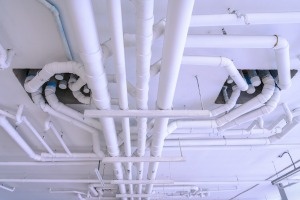 Demand in the US for behind-the-wall plumbing products is projected to advance 6.5 percent annually to $12.4 billion in 2020. The industry encompasses water distribution systems, which carry water from supply mains to fixtures and faucets; drain, waste, and vent (DWV) systems, which transport wastewater and other materials to sewer mains; and fire suppression systems, including valves and sprinkler heads.
Demand in the US for behind-the-wall plumbing products is projected to advance 6.5 percent annually to $12.4 billion in 2020. The industry encompasses water distribution systems, which carry water from supply mains to fixtures and faucets; drain, waste, and vent (DWV) systems, which transport wastewater and other materials to sewer mains; and fire suppression systems, including valves and sprinkler heads.
While demand continues to grow, manufacturers and plumbing contractors face new challenges related to water conservation. Stringent water use standards and low-flow fixtures — coupled with an increasing number of bathrooms in single-family homes — are stressing some waste systems in the US. Read more about the growing need for an ever more complicated network of pipes and valves to handle our modern needs.
Water Conservation Efforts
Government agencies urged the public to reduce water consumption by mandating the use of low-flow fixtures (particularly toilets) and such exterior fittings as showerheads and faucets. The US Environmental Protection Agency’s WaterSense program has encouraged consumers to use a wide range of water-efficient plumbing products to decrease water waste and lower utility bills.
In January 2014, the state of California, in response to a prolonged, statewide period of drought, enacted into law SB 407. Encouragement to reduce water use was then mandated by legislation. In May 2015, in the face of continuing water shortages, the governor of California issued Executive Order B-2915, a statewide mandatory water consumption reduction program. Per this order, as of January 2016 all toilets, urinals, and faucets sold in the state are required to meet even more stringent water use standards.
A Consequence of Lower Water Flow
One consequence of this push by California to reduce water use has been an increase in the amount of stress on DWV systems. As more low-flow fixtures and fittings are installed, waste streams will have a lower percentage of water, creating waste slurries that may damage pipes and fittings. Waste streams will move more slowly, putting more strain on the pipes and couplings in the systems. Manufacturers are working to develop DWV pipes and fittings that are better able to withstand these greater strains, while plumbing contractors will have to design systems that incorporate more supports to prevent pipes from sagging or breaking under the weight of the pipe load.
Increasing Number of Bathrooms
Through 2020, the number of single-family houses with two or more bathrooms is expected to rise, increasing demand for behind-the-wall plumbing products. Consumers will continue to opt for multiple bathrooms — particularly one on each floor of a house — because of their convenience. In many cases, these bathrooms will be located at some distance from existing water supply and sewer mains. This will boost demand for pipe and such fittings as couplings and supports as longer pipe runs will be needed to connect the fixtures in these bathrooms to the existing plumbing infrastructure.
To learn more about the demand for the pipes, valves, fittings, and sprinklers hidden behind the walls, see the recent industry study Behind-the-Wall Plumbing published by The Freedonia Group, a reliable and unbiased market research firm and a division of MarketResearch.com.
Corinne Gangloff
Media Relations Director
The Freedonia Group


